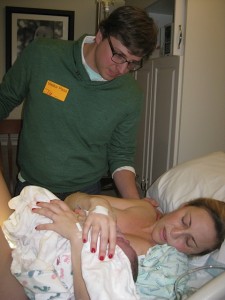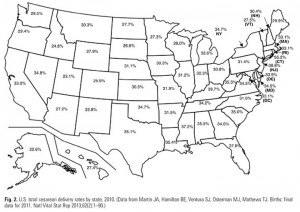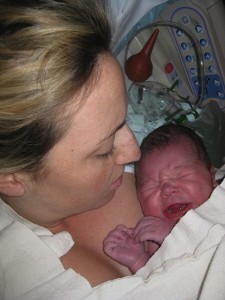If you are a mother who has had a low transverse uterine incision from a C-section and is interested in your birthing options then this is the post for you…
Many people ask me why having a VBAC (Vaginal-Birth-After-Cesarean) was so important to me. Why would I go through pain and medical risk when I could simply schedule a second C-section? For me, I was motivated to VBAC for two reasons: one personal and the other medical.

When my first son was born via an unexpected C-section, I felt robbed. I had just endured 36 hours of induced labor, dilated to 9.5cm and been forced to have a C-section when my son’s heart rate began to fall. It was over an hour after his birth, that I was first able to hold him and I missed the immediate skin-to-skin bonding time. Personally, I was weary of the operation itself and had hoped to give life the way my body was made to. But I was most disappointed in the fact that I felt disconnected and drugged in the first moments of his life.
While I am incredibly grateful for the medical capabilities that brought my first child into this world, I wanted desperately to avoid a C-section birthing experience the second time around.
I was also motivated to VBAC for medical reasons.
As a major abdominal operation, my C-section was difficult to recover from physically, and I could not imagine the burden of undergoing another recovery period while also caring for a toddler and newborn.
I was also motivated by the longer-term impact on my body and my future children: avoiding the increased risk of a weakened uterine wall, placenta complications, bladder injuries, heavy bleeding and potential hysterectomy.
While there are risks associated with a VBAC as well, including uterine rupture, I learned that these were very rare (<0.4% incidence) and by comparison less risky to a mother or child’s health than repeat C-sections.

With the help of a caring doctor, doula, and husband I achieved my all-natural VBAC at Baylor Hospital in Dallas at 41 weeks and 6 days to a healthy 9 pound baby boy. My body did what it was supposed to do and it was everything I dreamed it would be: bonding immediately with my child and feeling present for the entire experience. My VBAC was an incredibly empowering and moving moment and I cannot wait to do it again!
While I do not believe a VBAC is appropriate for every mother or every birth, I believe that every woman should be properly educated to make an informed decision. Below are some facts I’ve learned on VBACs and tips to plan for a successful VBAC in Dallas.
History of VBAC
For much of the last century, a woman who had a cesarean section almost always had a planned repeat C-section. But in the 1980’s and 90’s VBAC’s gained popularity beacause:
• Doctors began making the surgical cut in a different part of the uterus which is much less likely to open during a VBAC labor.
• A growing body of research established the high likelihood of safety with VBAC.
• Risks of a C-section, especially repeat C-sections, became clearer as the-C-section rate increased.
It is estimated that 70% of women who plan a VBAC can birth vaginally and avoid the complications of repeat cesarean surgeries, but the majority of women today have a repeat operation because most doctors and many hospitals refuse to allow VBAC. These restrictions are often the result of insurance policies, lawsuits concerns, or simply the convenience of a scheduled delivery.

7 Tips for a Successful VBAC:
1) Find the right doctor and consider a doula
My effort to VBAC required finding the right doctor. In my search, I was turned away from multiple doctors, one of which called me “selfish” for wanting a VBAC birth.
For a period of time, I was a patient of another doctor who had VBAC’d herself multiple times, instilling confidence that I had found the right person. This comfort, however, was short lived when, at five months, she urged me to put a C-Section on the calendar “just in case.” This was a red flag moment for me, supported by the fact that her hospital had less than a 3% VBAC success rate.
Eventually, I researched and hired a doula, Delilah Ray from Cherish Birth, with VBAC experience and started my third quest to find a VBAC-friendly doctor. Delilah’s experience facilitated this search, and I eventually met Dr. Yolanda Lawson at MadeWell OBGYN and knew she would be a perfect VBAC advocate. Delilah and Dr. Lawson were a dream birthing team, encouraging me through the entire process. I couldn’t have done it without them.
Some other suggested VBAC-friendly doctors, doulas, and hospitals include:
Doulas with VBAC experience
o Delilah Ray – Cherish Birth
o Maria Pokulda – Great Expectations Doula Services
o Abbey Robinson – Divine Birth Doula
VBAC experienced doctors
o Dr. Yolanda Lawson – MadeWell OBGYN Baylor Dallas
o Dr. Frederick Cummings – USMD – Denton Presby
o Dr. LeAnne Haddock – Magnolia OBGYN- Baylor Dallas
o Dr. Charles Downey – Richardson OBGYN – Richardson Methodist
VBAC friendly hospital
Highest successful VBAC rates in Dallas
o Baylor Dallas – 15.42%
o Richardson Methodist – 30.16 %
o Presbyterian Denton – 16.38%
Lowest successful VBAC rates in Dallas
o Medical City Dallas – 5.28%
o Presbyterian Dallas – 2.2%
o Presbyterian Plano – 3.61%
2) Know the facts & stats
Many of my initial visits to anti-VBAC doctors were filled with what I consider to be misinformation about the risks of a VBAC. While I do agree that there are specific risks to a VBAC above and beyond a repeat C-section, I feel that these are rare events when properly understood. For example, a VBAC birth does have a slightly greater chance of uterine rupture (+0.4% greater odds, or +1 in 258 VBACs), or even the death of the child due to uterine rupture (+0.02% greater odds, or +1 in 5,000 VBACs).
But, repeated C-sections also increase your risk of certain complications, which my initial doctors often failed to compare side-by-side. For example, the likelihood of developing placenta previa, or placenta accrete (which can have serious adverse consequences for both mother and baby) increases with the number of previous cesareans.
Given that I hoped to have more children, I found the escalating risks associated with C-sections concerning. With a deeper understanding of the data behind VBACs I was able to support my decision to others and defend the practice.
Other stats available at https://www.childbirthconnection.org

3) Go into labor naturally
Chances of a successful VBAC are greatly increased if you go into labor naturally. This means that you and your doctor are both comfortable waiting until 42+ weeks (if need be) and having a large baby. Avoid induction, pitocin specifically, and wait at home as long as you can before going to the hospital.
4) Consider natural childbirth
Moving around, bouncing on a ball and squatting greatly increases your chance of success. You are unable to do this with an epidural. If this is not of interest to you then you should try and wait as long as you possibly can before getting the epidural.
5) Take a class and be prepared
o Bradley Birth Class – http://www.bradleybirth.com
o HypnoBirthing – http://www.hypnobirthing.com
o HypnoBabies – https://www.hypnobabies.com
6) See a Webster Technique Chiropractor (specific for pregnant women)
o Dr. Ruth Durkee – http://www.handsforhealthchiropractic.com
o Dr. Tara Connolly – http://www.sozochiro.com
o Dr. Denisa Weber – http://www.drdenisa.com
7) Join a DFW VBAC support group – for encouragement, to hear others stories, peace of mind and to ask questions.
o Dallas Area Birth Network – http://www.birthnetwork.org/dallas.htm
o DFW VBAC/Cesarean Support Facebook group – https://www.facebook.com/groups/598482926880022/
This may seem like quite the process and frankly, you might be a bit overwhelmed after reading this but please take away from this post that as a woman, you have every right to give birth the way you want to give birth. Do not feel pressured to have another C-Section if you desire something different. You can reach this goal in Dallas…I did! I hope this post empowers you C-Section Mommy’s out there to ask questions and get informed! With whatever you decide I support you.














Medical Center of Plano – Dr. Hartley and a few doctors in her practice are willing to let you try for vbac!
I recently delivered a beautiful baby girl via VBAC at Medical City Dallas. I researched successful VBAC facilities and physicians early in my pregnancy. I am also very close to the natural birth community. I realize that Medical City Dallas doesn’t have the best reputation or numbers. However, my experience was amazing. My nurse at Medical City was a true advocate for me and my birth plan. She described herself using that description and she lived up to it. I was able to go into labor on my own and didn’t have pitocin. I did get an epidural but I had the option to go without. My physician was Dr Elmquist with Vernon & Waldrep… they are all willing to try a VBAC.